Muhammad Awais
INFN sezione di Padova, Italy, Università di Padova dipartimento di Fisica e Astronomia, Italy, Luleå University of Technology, Sweden, MODE Collaboration
MAGIC-Talk: Motion-aware Audio-Driven Talking Face Generation with Customizable Identity Control
Oct 26, 2025Abstract:Audio-driven talking face generation has gained significant attention for applications in digital media and virtual avatars. While recent methods improve audio-lip synchronization, they often struggle with temporal consistency, identity preservation, and customization, especially in long video generation. To address these issues, we propose MAGIC-Talk, a one-shot diffusion-based framework for customizable and temporally stable talking face generation. MAGIC-Talk consists of ReferenceNet, which preserves identity and enables fine-grained facial editing via text prompts, and AnimateNet, which enhances motion coherence using structured motion priors. Unlike previous methods requiring multiple reference images or fine-tuning, MAGIC-Talk maintains identity from a single image while ensuring smooth transitions across frames. Additionally, a progressive latent fusion strategy is introduced to improve long-form video quality by reducing motion inconsistencies and flickering. Extensive experiments demonstrate that MAGIC-Talk outperforms state-of-the-art methods in visual quality, identity preservation, and synchronization accuracy, offering a robust solution for talking face generation.
RespoDiff: Dual-Module Bottleneck Transformation for Responsible & Faithful T2I Generation
Sep 18, 2025Abstract:The rapid advancement of diffusion models has enabled high-fidelity and semantically rich text-to-image generation; however, ensuring fairness and safety remains an open challenge. Existing methods typically improve fairness and safety at the expense of semantic fidelity and image quality. In this work, we propose RespoDiff, a novel framework for responsible text-to-image generation that incorporates a dual-module transformation on the intermediate bottleneck representations of diffusion models. Our approach introduces two distinct learnable modules: one focused on capturing and enforcing responsible concepts, such as fairness and safety, and the other dedicated to maintaining semantic alignment with neutral prompts. To facilitate the dual learning process, we introduce a novel score-matching objective that enables effective coordination between the modules. Our method outperforms state-of-the-art methods in responsible generation by ensuring semantic alignment while optimizing both objectives without compromising image fidelity. Our approach improves responsible and semantically coherent generation by 20% across diverse, unseen prompts. Moreover, it integrates seamlessly into large-scale models like SDXL, enhancing fairness and safety. Code will be released upon acceptance.
How Effectively Can Large Language Models Connect SNP Variants and ECG Phenotypes for Cardiovascular Risk Prediction?
Aug 10, 2025



Abstract:Cardiovascular disease (CVD) prediction remains a tremendous challenge due to its multifactorial etiology and global burden of morbidity and mortality. Despite the growing availability of genomic and electrophysiological data, extracting biologically meaningful insights from such high-dimensional, noisy, and sparsely annotated datasets remains a non-trivial task. Recently, LLMs has been applied effectively to predict structural variations in biological sequences. In this work, we explore the potential of fine-tuned LLMs to predict cardiac diseases and SNPs potentially leading to CVD risk using genetic markers derived from high-throughput genomic profiling. We investigate the effect of genetic patterns associated with cardiac conditions and evaluate how LLMs can learn latent biological relationships from structured and semi-structured genomic data obtained by mapping genetic aspects that are inherited from the family tree. By framing the problem as a Chain of Thought (CoT) reasoning task, the models are prompted to generate disease labels and articulate informed clinical deductions across diverse patient profiles and phenotypes. The findings highlight the promise of LLMs in contributing to early detection, risk assessment, and ultimately, the advancement of personalized medicine in cardiac care.
Dual-Stage Value-Guided Inference with Margin-Based Reward Adjustment for Fast and Faithful VLM Captioning
Jun 18, 2025Abstract:Despite significant advances in inference-time search for vision-language models (VLMs), existing approaches remain both computationally expensive and prone to unpenalized, low-confidence generations which often lead to persistent hallucinations. We introduce \textbf{Value-guided Inference with Margin-based Reward (ViMaR)}, a two-stage inference framework that improves both efficiency and output fidelity by combining a temporal-difference value model with a margin-aware reward adjustment. In the first stage, we perform a single pass to identify the highest-value caption among diverse candidates. In the second stage, we selectively refine only those segments that were overlooked or exhibit weak visual grounding, thereby eliminating frequently rewarded evaluations. A calibrated margin-based penalty discourages low-confidence continuations while preserving descriptive richness. Extensive experiments across multiple VLM architectures demonstrate that ViMaR generates captions that are significantly more reliable, factually accurate, detailed, and explanatory, while achieving over 4$\times$ speedup compared to existing value-guided methods. Specifically, we show that ViMaR trained solely on LLaVA Mistral-7B, \textit{generalizes effectively to guide decoding in a stronger unseen model}. To further validate this, we adapt the ViMaR to steer generation in LLaVA-OneVision-Qwen2-7B, leading to consistent improvements in caption quality and demonstrating robust cross-model guidance. This cross-model generalization highlights ViMaR's flexibility and modularity, positioning it as a scalable and transferable inference-time decoding strategy. Furthermore, when ViMaR-generated captions are used for self-training, the underlying models achieve substantial gains across a broad suite of visual comprehension benchmarks, underscoring the potential of fast, accurate, and self-improving VLM pipelines.
SSLAM: Enhancing Self-Supervised Models with Audio Mixtures for Polyphonic Soundscapes
Jun 13, 2025Abstract:Self-supervised pre-trained audio networks have seen widespread adoption in real-world systems, particularly in multi-modal large language models. These networks are often employed in a frozen state, under the assumption that the SSL pre-training has sufficiently equipped them to handle real-world audio. However, a critical question remains: how well do these models actually perform in real-world conditions, where audio is typically polyphonic and complex, involving multiple overlapping sound sources? Current audio SSL methods are often benchmarked on datasets predominantly featuring monophonic audio, such as environmental sounds, and speech. As a result, the ability of SSL models to generalize to polyphonic audio, a common characteristic in natural scenarios, remains underexplored. This limitation raises concerns about the practical robustness of SSL models in more realistic audio settings. To address this gap, we introduce Self-Supervised Learning from Audio Mixtures (SSLAM), a novel direction in audio SSL research, designed to improve, designed to improve the model's ability to learn from polyphonic data while maintaining strong performance on monophonic data. We thoroughly evaluate SSLAM on standard audio SSL benchmark datasets which are predominantly monophonic and conduct a comprehensive comparative analysis against SOTA methods using a range of high-quality, publicly available polyphonic datasets. SSLAM not only improves model performance on polyphonic audio, but also maintains or exceeds performance on standard audio SSL benchmarks. Notably, it achieves up to a 3.9\% improvement on the AudioSet-2M (AS-2M), reaching a mean average precision (mAP) of 50.2. For polyphonic datasets, SSLAM sets new SOTA in both linear evaluation and fine-tuning regimes with performance improvements of up to 9.1\% (mAP).
PAL: Probing Audio Encoders via LLMs -- A Study of Information Transfer from Audio Encoders to LLMs
Jun 12, 2025Abstract:The integration of audio perception capabilities into Large Language Models (LLMs) has enabled significant advances in Audio-LLMs. Although application-focused developments, particularly in curating training data for specific capabilities e.g., audio reasoning, have progressed rapidly, the underlying mechanisms that govern efficient transfer of rich semantic representations from audio encoders to LLMs remain under-explored. We conceptualize effective audio-LLM interaction as the LLM's ability to proficiently probe the audio encoder representations to satisfy textual queries. This paper presents a systematic investigation on how architectural design choices can affect that. Beginning with a standard Pengi/LLaVA-style audio-LLM architecture, we propose and evaluate several modifications guided by hypotheses derived from mechanistic interpretability studies and LLM operational principles. Our experiments demonstrate that: (1) delaying audio integration until the LLM's initial layers establish textual context that enhances its ability to probe the audio representations for relevant information; (2) the LLM can proficiently probe audio representations exclusively through LLM layer's attention submodule, without requiring propagation to its Feed-Forward Network (FFN) submodule; (3) an efficiently integrated ensemble of diverse audio encoders provides richer, complementary representations, thereby broadening the LLM's capacity to probe a wider spectrum of audio information. All hypotheses are evaluated using an identical three-stage training curriculum on a dataset of 5.6 million audio-text pairs, ensuring controlled comparisons. Our final architecture, which incorporates all proposed modifications, achieves relative improvements from 10\% to 60\% over the baseline, validating our approach to optimizing cross-modal information transfer in audio-LLMs. Project page: https://ta012.github.io/PAL/
C3R: Channel Conditioned Cell Representations for unified evaluation in microscopy imaging
May 24, 2025Abstract:Immunohistochemical (IHC) images reveal detailed information about structures and functions at the subcellular level. However, unlike natural images, IHC datasets pose challenges for deep learning models due to their inconsistencies in channel count and configuration, stemming from varying staining protocols across laboratories and studies. Existing approaches build channel-adaptive models, which unfortunately fail to support out-of-distribution (OOD) evaluation across IHC datasets and cannot be applied in a true zero-shot setting with mismatched channel counts. To address this, we introduce a structured view of cellular image channels by grouping them into either context or concept, where we treat the context channels as a reference to the concept channels in the image. We leverage this context-concept principle to develop Channel Conditioned Cell Representations (C3R), a framework designed for unified evaluation on in-distribution (ID) and OOD datasets. C3R is a two-fold framework comprising a channel-adaptive encoder architecture and a masked knowledge distillation training strategy, both built around the context-concept principle. We find that C3R outperforms existing benchmarks on both ID and OOD tasks, while a trivial implementation of our core idea also outperforms the channel-adaptive methods reported on the CHAMMI benchmark. Our method opens a new pathway for cross-dataset generalization between IHC datasets, without requiring dataset-specific adaptation or retraining.
GeoVLM: Improving Automated Vehicle Geolocalisation Using Vision-Language Matching
May 19, 2025Abstract:Cross-view geo-localisation identifies coarse geographical position of an automated vehicle by matching a ground-level image to a geo-tagged satellite image from a database. Despite the advancements in Cross-view geo-localisation, significant challenges still persist such as similar looking scenes which makes it challenging to find the correct match as the top match. Existing approaches reach high recall rates but they still fail to rank the correct image as the top match. To address this challenge, this paper proposes GeoVLM, a novel approach which uses the zero-shot capabilities of vision language models to enable cross-view geo-localisation using interpretable cross-view language descriptions. GeoVLM is a trainable reranking approach which improves the best match accuracy of cross-view geo-localisation. GeoVLM is evaluated on standard benchmark VIGOR and University-1652 and also through real-life driving environments using Cross-View United Kingdom, a new benchmark dataset introduced in this paper. The results of the paper show that GeoVLM improves retrieval performance of cross-view geo-localisation compared to the state-of-the-art methods with the help of explainable natural language descriptions. The code is available at https://github.com/CAV-Research-Lab/GeoVLM
A data augmentation strategy for deep neural networks with application to epidemic modelling
Feb 28, 2025Abstract:In this work, we integrate the predictive capabilities of compartmental disease dynamics models with machine learning ability to analyze complex, high-dimensional data and uncover patterns that conventional models may overlook. Specifically, we present a proof of concept demonstrating the application of data-driven methods and deep neural networks to a recently introduced SIR-type model with social features, including a saturated incidence rate, to improve epidemic prediction and forecasting. Our results show that a robust data augmentation strategy trough suitable data-driven models can improve the reliability of Feed-Forward Neural Networks (FNNs) and Nonlinear Autoregressive Networks (NARs), making them viable alternatives to Physics-Informed Neural Networks (PINNs). This approach enhances the ability to handle nonlinear dynamics and offers scalable, data-driven solutions for epidemic forecasting, prioritizing predictive accuracy over the constraints of physics-based models. Numerical simulations of the post-lockdown phase of the COVID-19 epidemic in Italy and Spain validate our methodology.
One Model for ALL: Low-Level Task Interaction Is a Key to Task-Agnostic Image Fusion
Feb 27, 2025Abstract:Advanced image fusion methods mostly prioritise high-level missions, where task interaction struggles with semantic gaps, requiring complex bridging mechanisms. In contrast, we propose to leverage low-level vision tasks from digital photography fusion, allowing for effective feature interaction through pixel-level supervision. This new paradigm provides strong guidance for unsupervised multimodal fusion without relying on abstract semantics, enhancing task-shared feature learning for broader applicability. Owning to the hybrid image features and enhanced universal representations, the proposed GIFNet supports diverse fusion tasks, achieving high performance across both seen and unseen scenarios with a single model. Uniquely, experimental results reveal that our framework also supports single-modality enhancement, offering superior flexibility for practical applications. Our code will be available at https://github.com/AWCXV/GIFNet.
 Add to Chrome
Add to Chrome Add to Firefox
Add to Firefox Add to Edge
Add to Edge